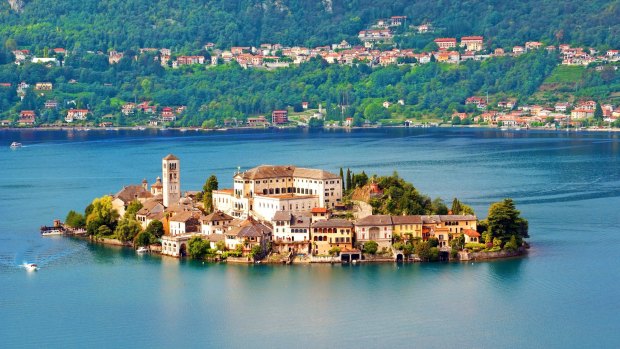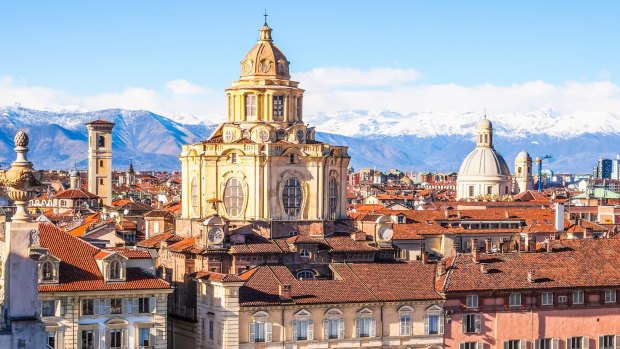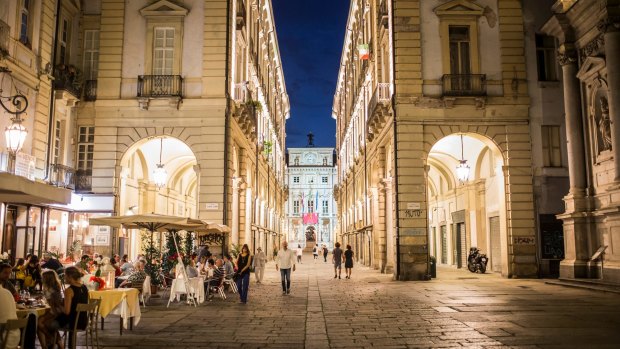This was published 5 years ago
Things to do in Piedmont, Italy: Insider's travel guide to Lonely Planet's must-visit region of 2019
By Pat Stringa

A restaurant along Lake Orta, Italy.Credit: Shutterstock
"Ciao, ciao, ciao, ciao!". The two-cheeked air kiss and hugs that greet me on my arrival to my family's hometown in Piemonte, is typical of the exuberant warmth many find when travelling to Italy. I've travelled to this north-western part of the country many times to catch up with family, and it's always a time filled with happiness, copious amounts of glorious food and wine, and excursions to new and surprisingly beautiful places.
All of Italy is, of course, a land rich in history, art and breathtaking landscapes. But the diverse appeal of the region of Piemonte, or Piedmont in English, has finally been placed into focus after international travel guide Lonely Planet selected it as the top region to visit in 2019.
There's much to be said about the region, from its rolling hills lined with grapevines – which, particularly in the Langhe area, give the more famous Tuscan hills a run for their money – to its lakes, the grand Alps on the French border and its elegant towns and cities. It's a gourmand's paradise and produces some of the most popular wines in the world, including the Barbaresco, Barbera and Barolo.

Julius Island on Lake Orta in Piedmont, Italy.Credit: Shutterstock
Tucked away in the north-western corner at the top of the boot, it caters for everyone but, thankfully, not everyone knows it's there yet.
While the well-known, and supposedly more glamorous regions that surround it, keep sucking up the attention and drawing millions of tourists, visitors to Piedmont can have a "real" Italian experience and at times be the only foreigner around.
I asked my family what they would suggest a visitor to the area should visit, or experience. Here are some of their highlights, and mine.

The church of San Lorenzo, Turin, Italy.Credit: Shutterstock
THE URBANITE: FIAT AND FOOTBALL
The capital of Piedmont, Torino (Turin in English), is reputedly the most elegant Italian city and the fourth largest in the country. It was once the capital of Italy and the home of the royal family of Savoy.
It was the centre of the industrialist boom of the early 1900s, becoming home to the country's most successful and well-known company, Fiat, and its owners, the Agnelli family.

Turin city centre.Credit: Shutterstock
Lingotto, the company's much celebrated factory built in the 1920s with a car test track on its roof that featured in the movie The Italian Job, has been refurbished by architect Renzo Piano. The area is home to an automobile museum, shops and eateries including the original Eataly store.
The historical centre of the city with its grand piazzas, cafes, wide avenues and arcades, resembles Paris' grand boulevards. Have a coffee, a bicerin (Torino's exquisite version of a mocha coffee) or hot chocolate (so thick you can stand your spoon in it) in one of its traditional cafes such as Caffe San Carlo, where the decor still reflects the Risorgimento, when intellectuals would meet to discuss the unification of Italy in the 1800s.
Torino is also the home of the master chocolate makers and the birthplace of the gianduiotto, chocolate made with cocoa and ground hazelnuts that have been grown in the nearby plantations in the Langhe. You'll find it sold in all the cafes, and the large chocolate shop franchises, such as Venchi. It truly is the best chocolate in the world.
There's plenty to satisfy those with more intellectual pursuits, of course. The Mole Antonelliana dominates the skyline, and now houses a cinema museum. The cathedral of San Giovanni Battista has on permanent display a copy of what many still believe to be Jesus' burial shroud. The Palazzo Reale, Palazzo Madama and its gardens, were home to royalty before Palazzo Carignano became the site of the first Italian parliament. The Egyptian museum, considered to be the biggest outside Egypt, is also worth a visit.
It's a football mad city, and home to two teams: Torino FC, founded in early 1906, and Juventus FC, founded in 1897. The Agnelli family has had control of Juventus since 1923 and still owns it today. La vecchia signora (the old lady) as is it known, is the only Serie A team that owns its state-of-the-art stadium, where daily tours are held.
THE OUTDOOR TYPE: SKIING AND HIKING
When the Piedmontese head to the slopes, they go to Sestriere, one of the five towns that make up the Via Lattea or Milky Way in the Alps. Only an hour's drive from Torino, many of the city's residents will visit the town for a weekend, or just a day. At a height of more than 2000 metres, there's always plenty of snow in the winter months, and the more than 200 kilometres of interconnected pistes cater to everyone's abilities.
While the town may not be picture perfect, having been built in the 1930s by the Agnelli family – you can pick up a T-shirt of playboy and style icon Gianni Agnelli in the souvenir shop – it is a good base for skiing enthusiasts and the surrounding mountains are breathtaking. It was home to the Winter Olympics in 2006, and has plenty of good lifts and facilities. If you want to escape the crowds found at many other resorts, try to visit on a weekday because most Piedmontese visit for the weekend.
The Milky Way stretches from the quiet small town of Cesana, through Sestriere, the apres-ski capital Sauze d'Oulx and across the border into the French town of Montgenevre – take your passport with you if you intend popping into France for lunch.
After a day on the slopes, take a snow cat from Sestriere to the Ristorante Alpette back up the mountain, where a menu of traditional Piedmontese mountain dishes and local wines await.
On a recent trip to Sestriere during summer, we were overwhelmed by the beauty of the mountains without the blanket of white powder that we had become accustomed to seeing. There are many tracks that wind around the mountains above the valley, all lined by towering pine trees, colourful flowers among the long grasses and the occasional cow wearing a bell around its neck.
THE FOODIE: CHEESE AND BACI DI DAMA
Those that say Italians are food-obsessed are not stereotyping – they really are. And the Piedmontese are no different. Piedmont is the home of Slow Food, a movement that promotes local food and traditional cooking, and the concept is very much part of the culture of the region. It is a foodie paradise.
Every area within the region has some specialities. Cheeses abound. Montebore, said to be the oldest cheese in the world, is still made in the town that gave it its name in the 12th century. Novara, in the north-east of the region, produces the best gorgonzola in the world. Traditional dishes include vitello tonnato, veal with a tuna and caper sauce, and bagna cauda, a colder-weather dish of fresh vegetables dipped in an oil and anchovy sauce..
In the southern areas of Piedmont the farinata, or belecauda, is sold as a takeaway dish. This pancake-like slice is made of chick pea flour and water, a perfect snack on colder days. Piedmont is also home to the truffle, and the prestigious white truffle is found in the hills surrounding the town of Alba. Many villages and towns hold fairs in October and November selling the underground fungus.
For me, one of the standouts in the area is the small sweet called baci di dama, or ladies' kisses, created in Tortona in the late 1800s and still produced by the same family, the Vercesi, in the area. It's two hazelnut biscuits are held together by chocolate supposedly to look like women's lips – perfect with a coffee.
THE CYCLIST: COPPI COUNTRY
The campionissimo, Fausto Coppi, is every Italian cyclist's hero. Coppi's birthplace in Castellania, a picturesque hilltop town in the south-east of the region, has a museum and what can only be described as a shrine dedicated to the cyclist, who during the '40s and '50s won five Giro d'Italia races and two Tours de France. Coppi's relatives still live in the town – one was the mayor for a number of years – and they will often have a chat with visitors about the legendary rider.
There are many off-road cycling paths in the countryside near Castellania, but they are usually short loops, under 20 kilometres, some of which have not been well maintained. Many cyclists ride on the narrow country roads in the surrounding hills, known as the Colli Tortonesi, and there are plenty of villages, such as Montemarzino, San Sebastiano and Garbagna to enjoy along the way, apart from just taking in the beautiful vine laden hilly vistas. The climbs in the Colli are shortish, but some have serious double-digit gradients. Don't forget, these are the strade di Coppi, and according to local cyclists, he is watching.
THE WATER LOVER: LAKES AND ISLANDS
Although the region is landlocked, there are lakes in its north. Lago D'Orta (Lake Orta) is a smaller lake with a pretty island and is considered a jewel of the region. It is visited by fewer tourists than the bigger neighbouring lakes and there are a number of public and free beaches along the shores, with one of the nicest a short walk from the historic centre of the town of Pettenasco.
The western bank of the Lago Maggiore, the second-largest lake in Italy, sits within Piemonte. From the town of Stresa, the Borromean islands can be reached by ferry. Isola Bella and Isola della Madre are the most spectacular, with grand villas and palazzi built in the 14th century, many with exotic gardens.
FLY
There are no direct flights to Turin-Caselle airport from Australia but it has good connections to other European cities. Major airlines fly to Milan's Malpensa airport, about 150 kilometres to the north-east of Turin, direct from Australia. See aeroportoditorino.it; etihad.com
TRAIN
All cities and major towns in Piedmont are connected by train or rent a car at the airport. See trenitalia.com; rentalcars.com; driveaway.com.au
Sign up for the Traveller Deals newsletter
Get exclusive travel deals delivered straight to your inbox. Sign up now.